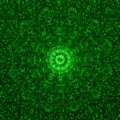Scientists from Kyoto University and Hiroshima University have identified a novel method of understanding the long-elusive W state of quantum entanglement, solving a decades-old challenge and opening new avenues to modern-day advances in quantum teleportation and computing.
The phenomenon of quantum entanglement was first described in 1935 by Albert Einstein, Boris Podolsky, and Nathan Rosen in what is now known as the EPR paradox. The trio argued against what Einstein famously called “spooky action at a distance,” the idea that the state of one particle could instantly affect another, no matter how far apart they were. These counterintuitive principles challenged classical physics in the early 20th century, and today they form the foundation of next-generation technologies, including ultra-secure communication networks, quantum computing, and the teleportation of quantum information.
That’s right—teleportation—but not in the science-fiction sense of beaming a person across space like in the famous transporter on board the Starship Enterprise in Star Trek. Instead, quantum teleportation refers to the transfer of quantum information between particles (usually photons) by exploiting quantum entanglement.
Traditional methods of quantum mechanics make verifying the “state” of multiple photons increasingly complicated, making such experiments difficult. Researchers have been able to explore certain entangled states, such as the GHZ state, but until now, there was no practical way to identify or measure the W state—another crucial type of multi-photon entanglement.
That barrier has now been overcome. Scientists at Kyoto University and Hiroshima University focused on the W state’s cyclic shift symmetry and developed a new entangled measurement technique using photonic quantum circuits and quantum Fourier transformation.
“More than 25 years after the initial proposal concerning the entangled measurement for GHZ states, we have finally obtained the entangled measurement for the W state as well, with genuine experimental demonstration for 3-photon W states,” says corresponding author Shigeki Takeuchi.
The new method enables the identification of W states in a “one-shot” measurement, eliminating the need for repeated trials. In tests with groups of three entangled photons, the team demonstrated that their device can reliably distinguish between different types of states. The system proved stable, able to run independently for long periods, and consistently accurate in its measurements.
The implications could be profound, as the team’s work may help propel the development of quantum teleportation (the transfer of information without moving physical particles) and accelerate measurement-based quantum computing—both fundamental to future computational processes. Potential applications include nearly unhackable communication networks for governments, banks, and critical infrastructure; powerful simulations in medicine, climate science, or materials research; and the eventual creation of a global quantum internet.
These advances could pave the way for technologies we can barely imagine today—perhaps even some form of teleportation in the far future.
“In order to accelerate the research and development of quantum technologies, it is crucial to deepen our understanding of basic concepts to come up with innovative ideas,” Takeuchi said in a statement.
Altogether, the breakthrough brings science one step closer to harnessing the full potential of quantum technologies and moves us closer to advancing quantum computing beyond theory and early demonstrations, and into practical reality.
Chrissy Newton is a PR professional and founder of VOCAB Communications. She currently appears on The Discovery Channel and Max and hosts the Rebelliously Curious podcast, which can be found on YouTube and on all audio podcast streaming platforms. Follow her on X: @ChrissyNewton, Instagram: @BeingChrissyNewton, and chrissynewton.com.


